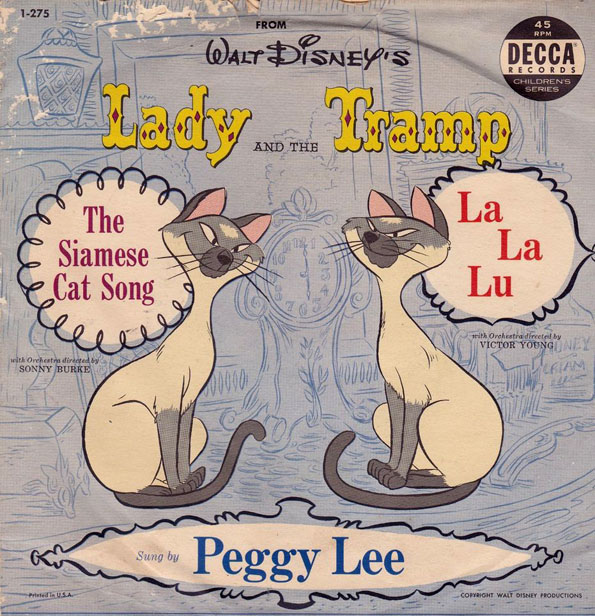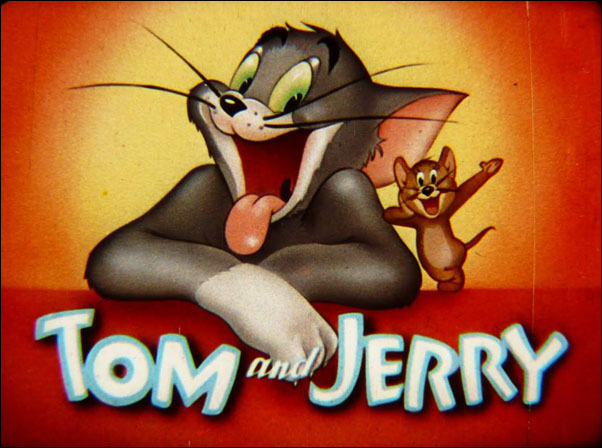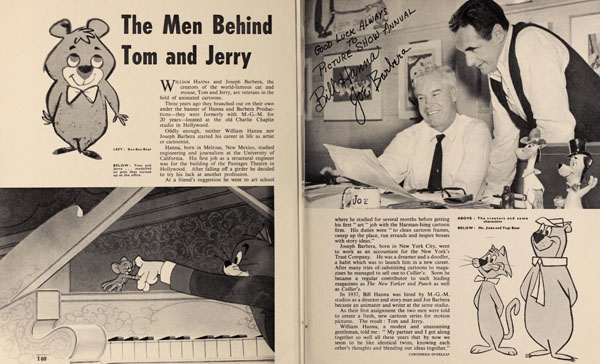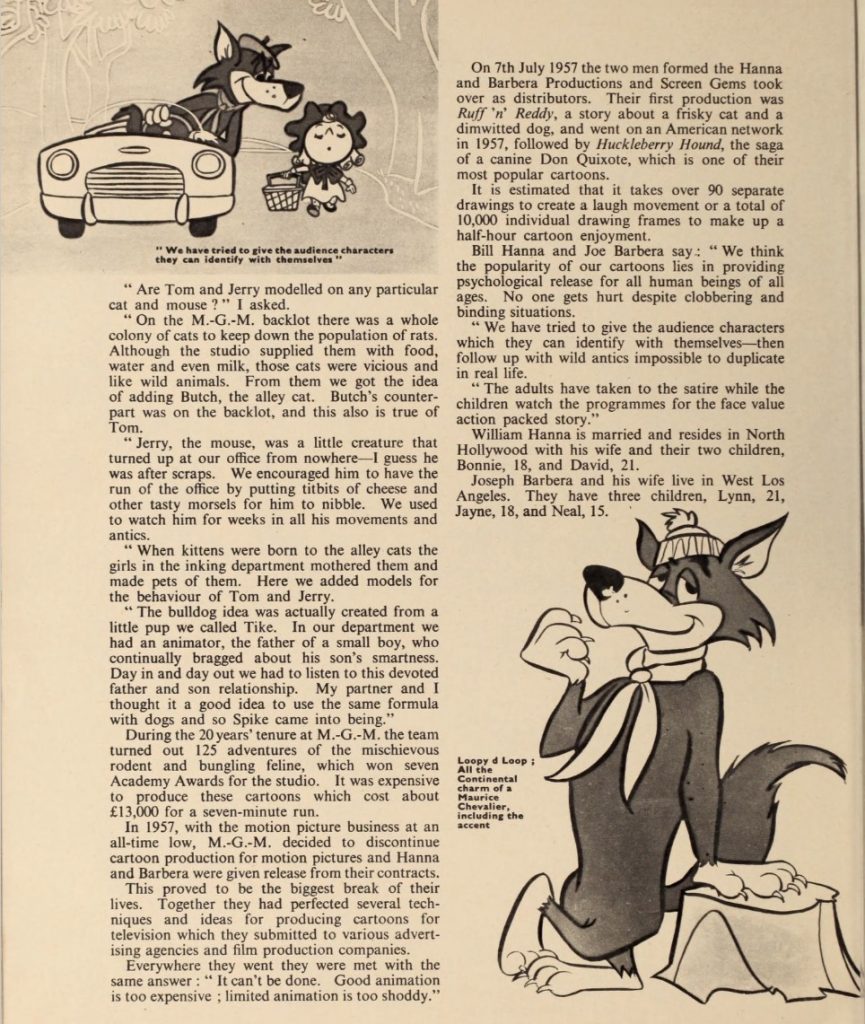
Who’s That Voice? From singer Peggy Lee’s autobiography Miss Peggy Lee (Dutton 1989), Lee talked about an incident when in her later years she was doing some promotional work for the film Lady and the Tramp (1955) where she not only provided voices for the mother Darling, Peg and the two Siamese cats but also supplied the songs. “I was doing an interview one day on CBS radio in San Francisco and had just finished a long, detailed description of what it was like to be originating a duet with myself; one voice singing the first part and then overdubbing myself to get the effect of the Siamese cats singing as Siamese twins. ‘There are no finer cats than I am’ to rhyme with ‘Siam’.
“The engineer put the needle down on the record and two strange voies came out singing, ‘There are no finer cats than WE are’ which of course does not rhyme with Siam or I AM. I was shocked. I named these cats Si and Am and that wasn’t even me. How could they do this? At this point the show’s host told the engineer to stop the record and we briefly discussed the possibility that this was a bootleg record. It wasn’t. I was number 1234, I believe, which is no longer released by Disney. I received an apology, sort of, from the product manager at Disney.”
Katzenberg on Merchandising. From the Boston Globe November 25, 1992 Jeffrey Katzenberg, then chairman of the Disney Studio said, “We’re extremely careful not to allow the tail to wag the dog. The merchandising evolves, following the success of the movie, not the other way around. For example, Beauty and the Beast will have its strongest showing merchandise this Christmas, not last year, when it opened. You really can’t plan for succes. You can try and anticipate it a little bit but when you plan for it, you don’t get it.
“Three of Disney’s nine old men are serving as consultants. We call upon them to critique, advise, lecture but I think the new generation has learned for itself. Today’s artists have found their own path. Roy E. Disney explained to Michael (Eisner) and I how important animation was historically for the company and under his leadership, one of our highest priorities became restoring animation, re-building it to the same prominence.”
The Betty Boop Situation. How did Betty Boop get in Who Framed Roger Rabbit (1988)? The filmmakers approached King Features about using Betty Boop and Popeye but were turned down. The filmmakers then tried approaching the Fleischer family directly who were incensed the KFS had turned them down without contacting the Fleischers because KFS does not own Betty Boop but only had a license from the Fleischer family. Richard and Ruth Fleischer owned the copyright to Betty Boop and Koko the Clown. The Fleischers made their own deal with the filmmakers and Betty ended up in the milestone film but Popeye who is fully owned by KFS does not.

Rasputin. From Film & Video magazine July 1997, co-producer/co-director Gary Goldman of Anastasia (1997) said, “Don (Bluth) created a lot of the original designs as well as the final designs and we started a lot of research on Rasputin. We even had another villain, Molotov, who was instrumental in the assassination of the family. After many meetings we realized that the film needed magic, an element that would make it an animated movie, so we just kept working away on (Rasputin).” Rasputin was already dead when the Romanovs were assassinated but the studio wanted to stay away from politics and not involve the real killers like Lenin. Bluth also created Bartok, the albino bat, to be a comedy sidekick for Rasputin.
Munro. Cartoonist Jules Feiffer was responsible for writing the story for the animated short Munro (1960), a whimsical story of a four year old boy who is inadvertently drafted into the army that won the Academy Award. It was directed by Gene Deitch. “Munro is my reaction against the mindless authority of the United States Army,” Feiffer told Video magazine May 1987. “I don’t think it’s anti-war. It’s anti-authority. It’s my first animated cartoon and it will be my last. Once you get into the habit of writing about real people and real situations, and get first-class actors to do your work, it’s hard to go back to animation.”
Designing for Filmation. “Heroes have to be pretty yet still distinctive,” said Filmation art director John Grusd (an industrial design major from Cal State Long Beach who joined Filmation in 1977) in an article in L.A. Times Magazine (December 28, 1986) that discussed the then-new animated series BraveStarr. “When you get an idea for a character in your head, it’s based on your intuition of what is going to work. That, combined with your experience of how animation works technically, is how you come up with an idea that’s not formula or run-of-the-mill.”

The Real Life Tom and Jerry. In the U.K. 1961 Picture Show Annual, animation producer William Hanna explained the real life inspiration for Tom and Jerry, “On the MGM backlot there was a whole colony of cats to keep down the population of rats. Although the studio supplied them with food, water and even milk, those cats were vicious and like wild animals. From them we got the idea of adding Butch, the alley cat. Butch’s counterpart was on the back lot and this also is true of Tom.
“Jerry, the mouse was a little creature that turned up at our office from nowhere. I guess he was after scraps. We encouraged him to have the run of the office by putting tidbits of cheese and other tasty morsels for him to nibble. We used to watch him for weeks in all his movements and antics.
“When kittens were born to the alley cats, the girls in the inking department mothered them and made pets of them. Here we added models for the behavior of Tom and Jerry.
“The bulldog idea was actually created from a little pup we called Tike. In our department we had an animator, the father of a small boy, who continually bragged about his son’s smartness. Day in and day out we had to listen to this devoted father and son relationship. My partner and I thought it a good idea to use the same formula with dogs and so Spike came into being.”
Reprint below – courtesy of Booksteve’s Library (Steven Thompson) – Click to enlarge.




 Jim Korkis is an internationally respected animation historian who in recent years has devoted his attention to the many worlds of Disney. He was a columnist for a variety of animation magazines. With his former writing partner, John Cawley, he authored several animation related books including The Encyclopedia of Cartoon Superstars, How to Create Animation, Cartoon Confidential and Get Animated’s Animation Art Buyer’s Guide. He taught animation classes at the Disney Institute in Florida as well as instructing classes on acting and animation history for Disney Feature Animation: Florida.
Jim Korkis is an internationally respected animation historian who in recent years has devoted his attention to the many worlds of Disney. He was a columnist for a variety of animation magazines. With his former writing partner, John Cawley, he authored several animation related books including The Encyclopedia of Cartoon Superstars, How to Create Animation, Cartoon Confidential and Get Animated’s Animation Art Buyer’s Guide. He taught animation classes at the Disney Institute in Florida as well as instructing classes on acting and animation history for Disney Feature Animation: Florida.




















































That’s what I want to know! Why was Betty Boop was the only “Monotone toon” that was selected to be in Who Framed Roger Rabbit?
Why none of other Toon stars of the Black and white era – including Foxy and Bosko, Beans, Oswald, Felix, Flip, Van Buren’s Tom and Jerry and numerous others?
By the mid ’80s, Betty Boop was probably the only pre-1933 character other than Mickey & Minnie Mouse that anyone still remembered. The other characters of that era disappeared from TV once color became commonplace in the mid ’60s. Those others you mention are all but irrelevant to the general public.
Probably because this was targeting a general audience, and most people, frankly, aren’t familiar with these characters. Betty Boop is more recognizable due to the large amount of merchandising. People who have never seen a Betty Boop cartoon will know she is.
Somewhere on the DVD it’s mentioned that they tried for Felix and didn’t get him. So they smuggled him in as a small, non-animated face painted above the tunnel that leads to Toontown.
I thought Felix was still fairly recognizable. At the very least Public Domain video companies made him the “Star” their collections. Usually one or two Van Buren Felix cartoons, maybe a later Pat Sullivan cartoon, with a few other shorts thrown in. Example tapes:
1) https://i.ebayimg.com/thumbs/images/g/7AYAAOSwTM5Y1wVR/s-l225.jpg
2) https://i.ebayimg.com/thumbs/images/g/0X4AAOSwUKxYZPl7/s-l225.jpg
3) https://i.ebayimg.com/thumbs/images/g/sL4AAOSwT6JZyAS0/s-l225.jpg
4) https://i.ebayimg.com/images/g/U6YAAOSwNnRYf0vI/s-l300.jpg
At least it gave Mae Questel a chance to voice Betty again, possibly for the last time.
For some reason Tom and Jerry weren’t used in “Roger Rabbit”, nor were any of the Terrytoons characters.
When Bill Hanna or Joe Barbera talk about the “origins” of TOM AND JERRY, in this case, it sounds as if they’re talking more about the alley cat that is the title character of the Hugh Harman cartoon, “THE ALLEY CAT”, who had a vicious streak to him and a ratehr incredibly scratchy voice. The synopsis of that cartoon, preserved in the Warner vaults, mentions that the alley cat in that cartoon actually has the name Butch and he spends a good part of the cartoon playing mean and painful tricks on the bulldog, Rover, even dropping a bulb on the dog’s head…and who will ever forget that cat’s rendition of “That Old Feeling”, complete with barber shop cat singers on the fence, backing him up!
The Alley Cat’s voice sounded familiar almost like Donald Duck. Could it be possible that Clarence Nash the voice of Donald Duck could of did the voice of the Alley Cat? Also Butch was changed from a Bulldog into a Cat and became the Chief nemesis of Tom
The alley cat in THE ALLEY CAT, while a prototypical Butch, was actually called Tom at the time—both on his model sheets and in the MGM SHORTS STORY publicity magazine.
(Interestingly, the SHORTS STORY promo piece shares the page with an article about THE MIDNIGHT SNACK—and while that film, as released, calls Tom Tom, he’s still Jasper in the SHORTS STORY article. Even though the mouse is Jerry…)
Thinking of Anastasia again, it’s interesting to see how the film’s plot developed over downplaying the obvious revolution in favor of Rasputin and the magic elements, but I could see why Don & Co. would go there.
It’s kind of odd how the Peggy Lee “Siamese Cat Song” “shocking” thing came about, especially she never actually sings that line in the movie:
https://www.youtube.com/watch?v=rlQYqQs0R3w
When Decca released the Lady and the Tramp album in 1955, a combination of soundtrack and studio version song, the soundtrack version of “Siamese Cat Song” was used. Ms. Lee also recorded a non-soundtrack single version that did indeed include the lyric as way recalled it. It contained several other lyrics also not included in the film:
https://www.youtube.com/watch?v=sfQg2sSt4cQ
However, since we may not know when this radio interview took place, both the single and the Decca album might have been long out of print. The Decca records were unavailable throughout much of the sixties and seventies making any soundtrack material totally out of reach, at least in stores.
The version that was most readily available was Tutti Camarata’s studio version, sung by an uncredited Robie Lester (her credit was not added until much later). Disneyland Records released this version in 1962 (on album DQ-1231) because they did not have the rights to the soundtrack, only Decca did. They could not use anything with Peggy Lee because of her contract with Decca. So when the station asked Disney for a recording, this was all they had.
Ms. Lee had no idea of any of this, I am sure, so the apology issued by the Disney sales representative was probably awkward because he was also confused (there were sales reps like this all over the country with varied knowledge of such details, and we can’t be sure where this interview took place). Only Camarata and Jimmy Johnson probably knew the specifics about the recording. Peggy Lee made press junkets for the movie every time it was reissued.
What she didn’t realize was that DQ-1231 and the storyteller LP version, ST-3917 (which I covered here on Cartoon Research: https://cartoonresearch.com/index.php/disneylands-lady-and-the-tramp-storyteller-records/), were available decades longer than her Decca versions. The Decca album was never reissued, though some tracks were included on a Disney picture disc and some CD collections. DQ-1231 can be downloaded and is included on the Lady and the Tramp Legacy Collection CD. The Storyteller album has been reissued in its original vinyl form.
The lyric “there are no finer cat than I am” does indeed rhyme better than “we am.” but a decision must have been made to change it because there are two voices singing it. The recording is aimed at children and perhaps it was thought the grammar should be correct. Plus, Robie Lester repeats the “we am” line to the fade over and over again, and it is two voices, not one.
https://www.youtube.com/watch?v=c1nlUTYnrQk
So very sorry, Ms. Lee. And sorry for the long-winded answer, but it is as you might have gathered, for the record.
Oops! I read the post again and the interview took place in San Francisco. So there was a sales rep was assigned to that territory. We am mistaken!
“I don’t think it’s anti-war. It’s anti-authority” Love how the Army is the target of anti-authority. Try telling a Hollywood Director you have a problem with authority on the set and watch what happens.
It was mindless authority that gave us Cimino’s Heaven’s Gate.